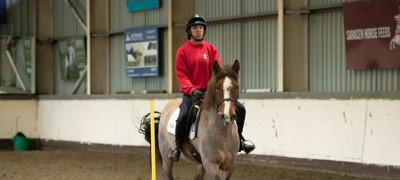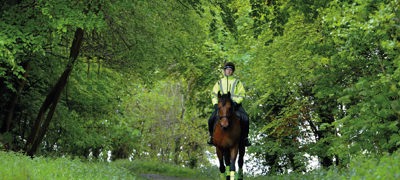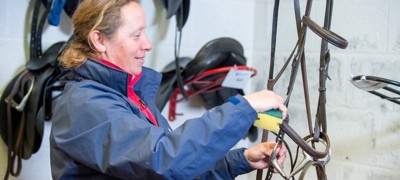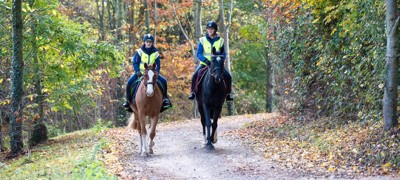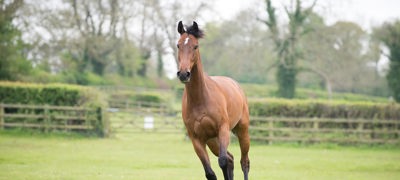Are you and your horse the right fit?
Riding a horse that you are too big or small for can cause welfare issues, so whether you’re a horse owner, looking for a horse, or rider at your local centre, it is helpful to know how your size and shape can influence the type of horse that can carry you comfortably.
Find a horse to suit your size
If you have ever sat on a horse that is not the right size or shape for you, one of the first things you will notice is that you don’t feel comfortable. If you aren’t comfortable on a horse, you’ll constantly change your position, which affects how your horse moves as they’ll have to rebalance themselves each time your balance changes.
To make sure you and your horse are the best match, there are several points to consider, including your and your horse’s:
- Height and weight
- Saddle fit
- General fitness
- Ability and the riding activities you want to do together
Rider height
If the rider feels too tall or short for the horse they are riding, they may find it more challenging to achieve a balanced position and control the horse.
It makes sense that tall riders need tall horses and smaller riders need smaller horses, but it isn’t only the height of a horse that needs to be considered.
The width of the horse also plays a part. Some horses have a wide barrel (width of body), which provides more room to ‘take up’ the rider’s leg, meaning a shorter horse can accommodate a tall rider. A shorter rider might find a narrow horse easier to ride, whereas a taller rider might feel top-heavy and unbalanced.
If the horse is too big for you
chevron-down
chevron-up
Riding a horse that is too big or too wide for you places extra strain on your hip joints and muscles, making it harder for you to absorb the horse's movement. When the rider can’t absorb the movement of the horse, it affects the horse’s ability to move correctly.
Also, depending on your riding ability, you may not have the body strength to be effective on a big horse, which can lead to feeling over-horsed and a potentially dangerous situation if you can’t maintain control.
If the horse is too small for you
chevron-down
chevron-up
If you feel too tall for your horse, you will end up compromising your position by leaning your upper body forward and lifting your lower leg up every time you use it.
When you aren’t sitting in a balanced position it affects how your horse moves. If the horse has to compromise their movement over a period of time it will have an effect on their soundness
Rider weight
Weight can be a sensitive subject, but it is crucial that, as a rider, you consider the weight your horse can carry. This includes the weight of the tack and equipment, as well as the rider.
Most BHS Approved Riding Centres will have rider weight and potentially height limits in place for each of their ponies and horses to help protect their welfare. You’ll be matched to a horse based on your size and riding ability, so it’s important that you give the centre accurate information so that they can choose the most suitable horse for you.
How do I know if I'm too big for my horse?
A horse carrying a load that is too heavy for them will start showing signs of stress and pain due to the extra strain placed on their back.
Immediate signs of discomfort
chevron-down
chevron-up
- Tension through the neck and back
- Reluctance to move forwards
- Reduced performance
- Intermittent lameness
- Stumbling
- Increased breathing
- Tiring quickly
These signs may disappear as soon as the rider dismounts, but if the horse is repeatedly placed under excess strain, it may cause permanent damage and affect their long-term soundness.
Other signs to be aware of
chevron-down
chevron-up
- Pain or discomfort along the back
- Longer periods of lameness
- How they react to being tacked up
- Change in muscle tone
- Change in behaviour
- Altered movement
Seek support from your vet if you notice any of the above signs as they may also be indicating other issues in your horse’s physical and mental wellbeing and should always be investigated.
How much weight can a horse carry?
There isn’t a simple answer to this question, as there is no one formula that fits all, and the answer will be different depending on both the individual horse and rider.
It’s not simply based on the size of the horse but also their age, conformation, muscle development, fat score, fitness and breeding, as some breeds have a natural ability to carry more weight than others. Each horse should be looked at and assessed as an individual. For example:
- There’s some evidence that horses with thicker leg (cannon) bones and more muscular backs had better weight-carrying ability than those with finer leg bones and less muscular backs
- You’ll need to consider whether your horse is carrying any excess body fat: an overweight horse may already be carrying 50kg of excess weight before a rider and tack are added. If a horse is overweight, it doesn’t mean they’ll be able to carry a larger rider.
- A horse who has suffered previous injury or illnesses (such as tendon damage or arthritis) will benefit from carrying a lighter load and should only be ridden within their workload limits and following a vet’s approval.
- Duration and intensity of the work they’ll be doing should also be considered: a horse that does 30-minute walk hacks has a different energy demand than a horse working in an arena.
The fitness and ability of the rider also play a part. Beginner riders tend to be more unbalanced than more experienced riders. An unbalanced load is harder for a horse to carry as it places more strain on them. The uneven weight distribution caused by an unbalanced or unfit rider can lead to lameness and other issues as the horse has to alter how they move to compensate for the rider.
Saddle Fit
It’s important the saddle fits both you and your horse.
The length and type of saddle a horse can carry comfortably is influenced by their size and conformation. In general, the bigger the horse, the longer the saddle they can carry, but not every big horse is capable of carrying a big rider. A saddle must fit your seat comfortably and allow you to sit in the centre of the saddle in a balanced position.
Your body proportions need to be taken into consideration too. Riders with long legs or long thigh measurements often need longer saddles to accommodate their leg length and stop their knee going over the knee roll. Continually riding in a saddle that isn’t the right size for you will have a detrimental effect on both you and the horse you are riding, no matter how well fitted to the horse it is. Your weight will be distributed unevenly through the saddle and across the horse’s back, creating pressure points and restricting the horse’s movement. Over time, this can lead to uneven muscle development and soreness and potentially long-term injury to the horse.
Learn more about the correct tack fit for your horse.
All riding schools in the UK are licensed and undergo yearly tack inspections with the Local Authority appointed veterinarian. At BHS Approved Centres, the horses will have their saddles fitted to them, which will be suitable for the type of work the horse does. If you find the saddle uncomfortable, make sure you tell your coach.



